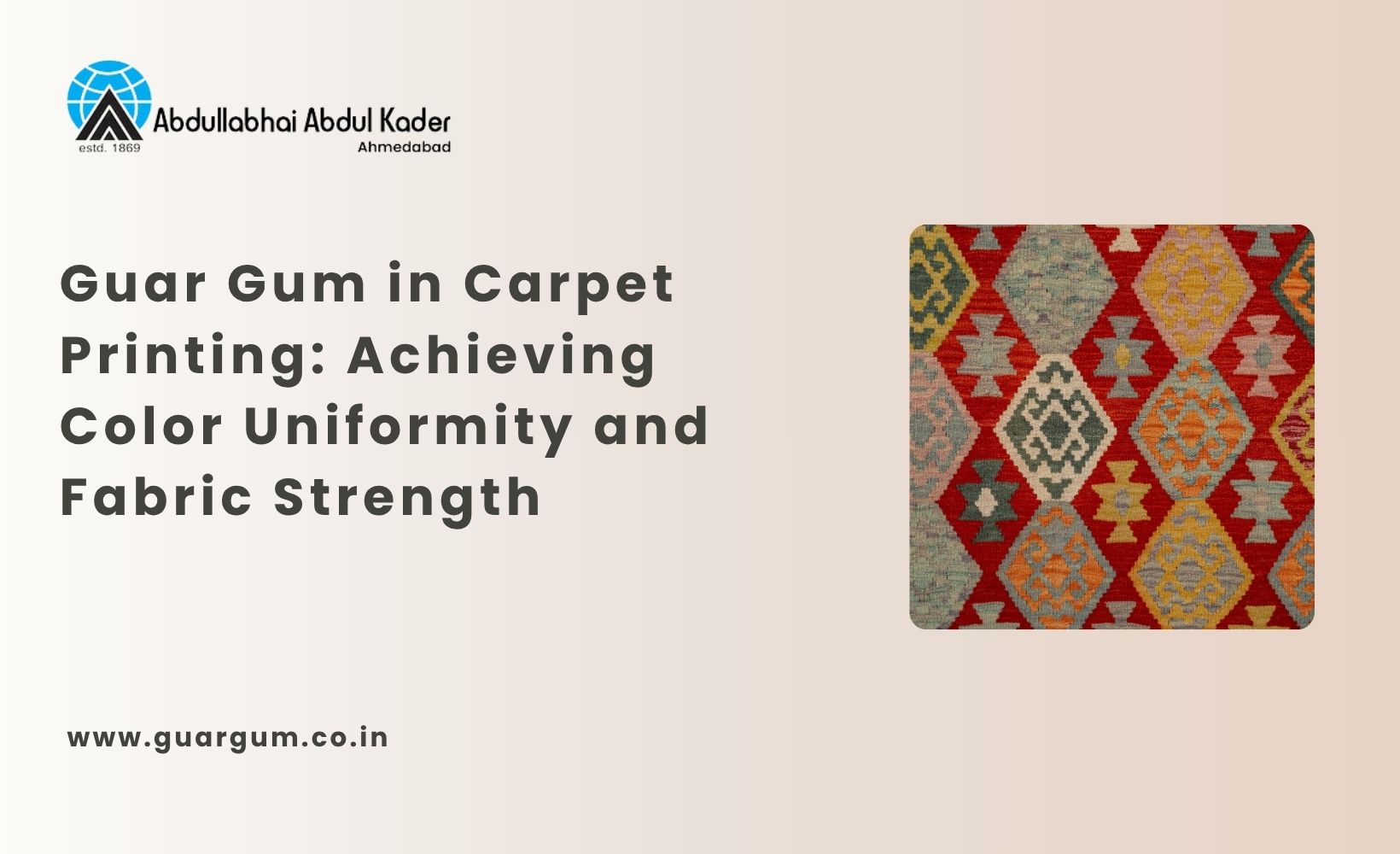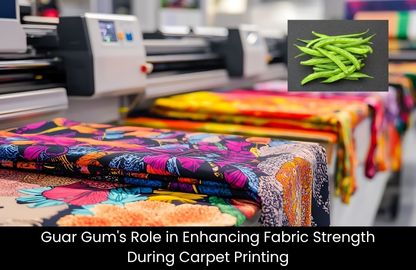
Objective:
This article explores the role of guar gum in carpet printing, specifically its contribution to achieving color uniformity and fabric strength. It delves into the technical aspects of how guar gum powder and its formulations interact with dyes, fabrics and printing processes to maintain consistent quality in carpets.
Introduction
Carpet printing involves the precise application of dyes and patterns onto woven fabrics. Maintaining uniformity in color distribution and ensuring fabric integrity throughout the printing process are critical for producing high-quality carpets. Guar gum, a natural polysaccharide derived from guar seeds, has been extensively used in carpet printing for its ability to control viscosity, stabilize dye solutions and support the structural strength of the fabric during processing.
Industrial guar gum powder, often referred to as guar powder or guargum powder, plays a significant role as a stabilizer in carpet printing applications. By influencing the flow and absorption of dye pastes, guar gum ensures even penetration into the fibers while maintaining the mechanical properties of the textile.
How Does Guar Gum Powder Influence Color Uniformity in Carpet Printing?
Guar gum powder acts as a thickening agent that modifies the rheology of dye pastes used in carpet printing. The viscosity adjustment provided by guar gum can control the spread of dye across the fabric surface, ensuring that the color is deposited evenly on both natural and synthetic fibers.
By stabilizing dye suspensions, guar gum prevents pigment settling, which may otherwise result in uneven color patches or streaks. This property is particularly important when printing intricate patterns, as inconsistent dye flow can compromise the visual design. Guar gum powder may be blended in precise concentrations to achieve the desired consistency, allowing printing machines to apply dyes uniformly across large carpet sections.
Moreover, guar gum in carpet printing supports the retention of water-soluble dyes on the fabric surface during the drying process. It helps in minimizing migration or bleeding of colors, which is essential for maintaining the integrity of patterns and the overall color consistency across the carpet.
What Role Does Guar Gum Play in Maintaining Fabric Strength During Printing?
During carpet printing, the fabric undergoes multiple wetting, dyeing and drying cycles. The application of guar gum powder in printing pastes can influence the fabric’s tensile properties and structural stability throughout these processes.
Guar gum forms a gel-like matrix when hydrated, which may support fibers and prevent undue stress during mechanical handling. This stabilizing effect ensures that the weave of the carpet remains intact, reducing fiber distortion, shrinkage or breakage.
In high-speed printing processes, where fabrics are subjected to tension and repeated passage under rollers or screens, guar gum powder may serve as a protective agent by evenly distributing mechanical stress. The controlled viscosity of guar gum-based pastes may reduce the formation of weak spots in the carpet, preserving the strength of the fibers while the dye is applied.

How Is Guar Gum Powder Applied in Carpet Printing Processes?
Guar gum can be incorporated into carpet printing formulations in various ways depending on the printing technique employed.
- Screen Printing:
In screen printing, guar gum is mixed with dye pastes to adjust viscosity and improve adhesion on the carpet surface. Its stabilizing properties prevent dye sagging or spreading beyond the intended pattern, achieving sharp edges and consistent color application. - Block and Roller Printing:
For roller or block printing, guar gum powder can regulate the flow of dyes applied via engraved rollers or blocks. By maintaining a uniform thickness of the paste, guar gum ensures that each impression transfers the same quantity of dye, resulting in uniform pattern intensity across the fabric.
- Stenciling and Jet Printing:
Modern carpet printing techniques, including digital jet printing, benefits guar gum in the formulation of ink solutions. The powder helps maintain consistent droplet size and deposition, which may be critical for reproducing fine designs without color inconsistencies or smudging. - Paste Preparation:
In all techniques, guar gum powder is hydrated prior to mixing with dyes to form a homogenous paste. Proper hydration ensures that the gum achieves optimal thickening and stabilizing properties, which can be controlled to suit the type of fiber, dye concentration and printing speed.
Which Types of Guar Gum Are Most Effective for Carpet Printing?
The industrial-grade guar gum powder used in carpet printing is generally selected for its high viscosity and purity. Depending on the specific application, guar gum stabilizer formulations may be optimized for:
- Viscosity Control: Adjusting the flow properties of dye pastes to match different carpet materials such as wool, synthetic fibers or blended yarns.
- Compatibility with Dyes: Ensuring that the guar gum does not interfere with the chemical composition of reactive, acid or disperse dyes used in carpet printing.
- Consistent Gel Formation: Producing a uniform gel upon hydration to stabilize the dye suspension and support fabric fibers during application.
High-quality guar gum powder suppliers often provide grades suitable for textile applications, ensuring reproducible results in color uniformity and fiber integrity.
What Are the Key Considerations When Using Guar Gum in Carpet Printing?
Several technical factors may influence the performance of guar gum powder in carpet printing:
- Concentration of Guar Gum: The amount of guar powder added to dye pastes can affect viscosity, flow and penetration. Precise measurement ensures that the fabric receives adequate coverage without over-thickening the paste.
- Hydration Method: Guar gum must be hydrated properly to achieve maximum thickening potential. Insufficient hydration may lead to uneven paste consistency, while overhydration may reduce viscosity control.
- Dye Interaction: Guar gum should be compatible with the type of dye used in carpet printing. This ensures that the stabilizing effect of the guar gum does not compromise color development or fixation on fibers.
- Fabric Type and Weave: The properties of the carpet fibers, including density, material composition and weave pattern, can influence how guar gum stabilizes the dye and maintains fabric strength.
- Processing Conditions: Temperature, shear rates and drying time during printing may affect the performance of guar gum in maintaining color uniformity and fiber support. Controlled conditions can optimize its effectiveness.
How Can Guar Gum Powder Suppliers Ensure Quality for Carpet Printing?
Guar gum powder suppliers focusing on carpet printing applications may adhere to certain quality parameters:
- Consistency in Viscosity: Each batch of guar gum powder should exhibit uniform thickening properties to produce predictable printing results.
- Purity and Contaminant Control: Impurities may affect the color outcome and fiber integrity. High-purity guar gum ensures reliable performance.
- Particle Size and Solubility: Fine and easily soluble guar powder facilitates rapid hydration and smooth paste formation, critical for uniform dye application.
Conclusion
Guar gum plays a pivotal role in carpet printing by influencing both color uniformity and fabric strength. Its ability to stabilize dye pastes, control viscosity and support fibers makes it an essential ingredient in producing high-quality carpets with consistent color patterns and structural integrity. Industrial guar gum powder, when selected and applied appropriately, can maintain the reliability of printing processes across diverse carpet types and printing techniques.
By understanding the interactions between guar gum, dyes and carpet fibers, textile manufacturers can achieve precise control over color deposition and fabric stability, ensuring a superior finished product. Proper selection, hydration and application of guar gum powder can optimize both the aesthetic and structural outcomes in carpet printing, making it a fundamental component in modern textile processes.



